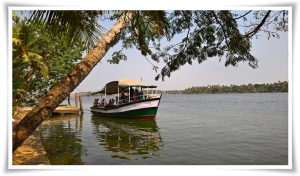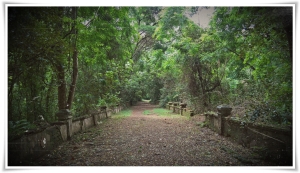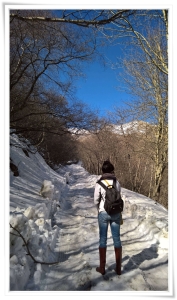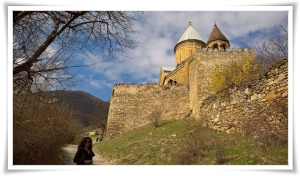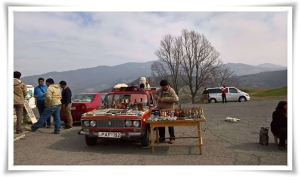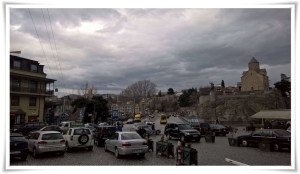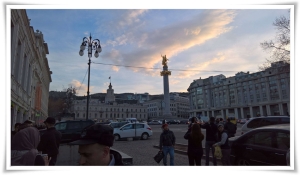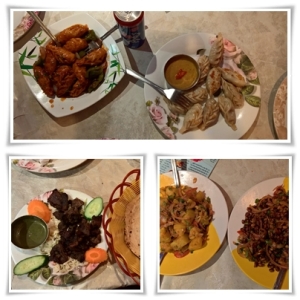Archive
Sharjahscapes
Sharjahscapes
 Suburban morning incinerated by winter sun….
Suburban morning incinerated by winter sun….
 Lazy afternoon by the Corniche…..
Lazy afternoon by the Corniche…..
Photographs taken with Microsoft Lumia 950XL
Uphill
 The clouds hovered intimidatingly close and oozed out through my skin in copious perspiration. I did not feel the usual enthusiasm when we climbed the pass from Thamarassery to Lakkidi. The oppressive heat of the plains, the pollution and traffic at Calicut, the long journey and the hurried nature of the visit – even though we were coming back after a hiatus of 5 years – all of that put me in a bleak and restless mood.
The clouds hovered intimidatingly close and oozed out through my skin in copious perspiration. I did not feel the usual enthusiasm when we climbed the pass from Thamarassery to Lakkidi. The oppressive heat of the plains, the pollution and traffic at Calicut, the long journey and the hurried nature of the visit – even though we were coming back after a hiatus of 5 years – all of that put me in a bleak and restless mood.
The rain exploded on us just as we reached Lakkidi. Wipers swayed frantically to sweep off the cascade that flowed over the windshield. World was a blur of green and grey for half an hour; then the rain stopped just as suddenly as it had arrived. The sky had cleared by the time we reached Vythiri. Sun was blazing again in all glory turning the inside of the car into a furnace. There were small muddy rapids beside the road; the pot holes were full and sloshing; sun light glinted sharply off wet leaves.
This had been the pattern of rainfall for the past couple of years in Kerala. It never rained steadily anymore during monsoon. Instead, it rained intermittently – brief spells of rain followed by sunshine and an accompanying sweaty heat. Rain did not sink into the soil replenishing ground water. When summer came there were droughts, something unheard of in Kerala, except in and around Palakkad.
The catchment area of Banasura dam was devoid of water except for a few insipid pools. Cows grazed in the barren floor on small patches of grass which must have sprung up after the onset of monsoon. Normal showers were expected this year, yet monsoon was indolent even though it was mid June.
At Korom our hosts plied us with flavoured tea and biscuits. Sitting on the verandah and gazing over the panorama of peaks and valleys splashed in green I eventually got over my gloom. The evening breeze was fragrant with a pleasant chill. For the moment I was deeply content.
Someone mentioned a local store at Kalpetta which sold forest products. The shop “Thanima” turned out to be a treasure trove.There were different varieties of honey (squeezed out with bare hands from the honeycombs) – Cheru Then & Puttu Then (honey from holes in the ground); types of rice which I had never heard of – Mula Ari (bamboo rice) and Gandhakasala Ari; there was Naruneendi Sarbath; there were crunchy ginger flakes laced with sugar – a panoply of interesting stuff. The shopkeeper was quite knowledgeable and did not mind showing it off, even giving us tips on cooking some of the things we bought.
Our visit was brief and intense, just like the sporadic but pounding rain, but the flavours of Wayanad lingers as we dip into the honey and ginger crumbs each day…
A few frames
Five shades of grey
Kerala is hauntingly beautiful during the monsoon.
The eerie, surreal light that pervades the sky in anticipation of rain is a sight to marvel.
Here are a few vignettes that lets you drench in the atmospheric setting…
A country by three dawns
Landed in Georgia early morning in late February. Women officers with steely eyes at the immigration counters in military style dark blue vests. A legacy of Russian rule? Outside in the semi darkness gypsy children grabbed me by the arms, no letting go till you shell out some Dirhams. Found it difficult to keep eyes open on the long drive to Gudauri. . The city appears drab and dingy by street light. Stepped out onto crunchy snow at the hotel in Gudauri. Our room was wood panelled room with large windows opening into a wide valley and mountains beyond. A thick blanket of snow layabout like candle wax over everything hushing all life. A blade of golden light is faintly playing on a mountain top. The dawn is about to break upon this icy abode.
I stand in the bath room naked, early morning sun warming my torso. A solitary skier is waddling over snow leaving a soft trail in his wake. The toilet bowl had funny design unlike ever seen before. I marvel at it. It’s the exact opposite of what is normal. Was it a mistake or is there an intelligent design behind it. Yet to fathom. Back in the bedroom it’s cold. I pull the heavy curtains closed and snuggle under the blanket. My wife is fast asleep, only her forehead visible under the rough quilt.
Breakfast is continental. There are several Russians and some guests from Philippines at the table. I stuff myself up on of country cheese.
Our Holidayfactory booking does not cover anything except the stay at the hotel. Upon request our hostess manages to arrange transportation for us to Kazbegi. All along the road a thick layer of snow lay in various formations whitewashing every detail. It dominates every sense, and draws attention to itself at every turn. The glare of the sun is blinding. It is similar to what we had experienced during our visit to Antarctica. The sheer cliffs and steep valleys are mesmerizing. The road is narrow, two lane with several dark, wet and dingy tunnels before which we are forced to patiently wait for huge 18 tonner trucks to pass. The trucks are en route to Armenia from Russia via Georgia ever since Turkey has closed it’s borders following disputes with Russia.
Kazbegi was a large town with broad streets, nestling under a towering mountain. The village Gergeti in which the antique church to which we were planning to walk up to stood across the road from it. Our jeep coughed up the narrow alleyways of the village, where old men bunched together and smoked and portly women in native attire screwed their eyes and stared at us, and came to rest near the grilled walls of a cemetery.
We soon realized that our shoes were not appropriate for the climb. Snow had melted into muddy slush and in no time soaked through our shoes. Elsewhere it had hardened into slippery ice. After several falls, smashing through shrubbery to avoid ice , being impaled by a recalcitrant cow, and futile attempts to support ourselves with birch branches, we managed to reach a plateau, about three quarters of the climb to the church. We constantly reprimanded ourselves for our mistake and hardly enjoyed the beautiful scenery around us. The corridor or leafless birch trees where we paused before our next skid and fall was especially sublime, the beauty of which was lost on us completely. Beyond the plateau we would have to push through knee deep snow. Although we desired to go on, the exertion so far had already taken its toll and abandoned our quest. We walked moodily about a bit and decided to return. The walk down filled us with fear of slipping and there seemed no solution except to request a ride in one of the cars which had brought other tourists to the plateau before they climbed up. Fortunately we could hitch a ride in a van which had brought some Russian tourists. On the way down it lurched from side to side and growled in the deep grove of snow. The switchbacks were especially precarious and narrow. The van stopped an inch from the cliff and shifted into reverse gear before finding enough space to turn and veer off. The ride was fun, hanging on to dear life while listening to soulful Russian music.
From Kazbegi we went to the Russian border before returning to Gudauri. This visit was a waste of time since we had to drive a long way along a pot holed road beside a wide river just to have a glimpse of a border control building from the car . Probably I can brag about it someday…
For lunch we had Imerouli Khachapuri, a leavened bread stuffed with cottage cheese with a tangy flavour baked in the shape of a thick pan cake, and fried pork. The quantity was substantial, and we ended up like stuffed dolls with no appetite for anything whatsoever for the rest of the day. We also visited the local supermarket where we stood out like a light house, being the only dark skinned people in town. People were cordial and not overly inquisitive; so we did not feel uncomfortably out of place.
Language wasn’t much of a barrier since most young people spoke reasonably good English. The old only spoke Georgian and Russian, so they were usually taciturn in communication, though generally affable.
The return journey from Gudauri to Tiblisi took us through pristine countryside and occasional towns with run down factories which perfectly fit our mental image of Soviet era communes. Even the most decrepit looking towns had state of the art, concrete and glass police stations which to me looked life a left over of the totalitarian politics under USSR. There were several Russian made Lada cars on the road which our guide dutifully informed only looked ramshackle but had tremendous horsepower. We stopped to look at one of the several roadside stalls selling local honey and country wine. The wine turned out to be undrinkable, tasting more like arrack than wine.
At Ananuri we visited the old orthodox church briefly. A pious old lady in ominous black glided from candle stand to candle stand , lighting each. An intense fragrance of frankincense filled the room. In the pervading gloom, I could pick out the glittering Cyrillic script gilding the edges of murals on the pillars. Outside the church, the air was fresh and minty. Several women, young and old, sold kitschy souvenirs on colourful makeshift stands. We bought a wine glass made of cow horn after being assured that it is an authentic specimen of Georgian country craft.
Tourists were pouring in, mostly Indian, Filippino and Arabic; western tourists were conspicuous by their absence. Possibly, the communist background of the country put them off or there wasn’t enough prostitution to attract them. Georgia was not an expensive destination which accounted for the money conscious Indian traveller. Although the Lari (Georgian GEL officially) was more valuable than the Dirham, food, stay and travel was quite affordable, noticeably accentuating the perceived value for money.
The hotel room we checked into at Tiblisi was small, with just enough room to slide around the edge of the bed. It was located on George Bush street. An imposing print of the ex-president pensively stared at you as you emerged out of the under pass. This was a sign of the change in times and affiliations. One is astonished to notice several expensive cars, especially Japanese 4×4’s on the streets of Tiblisi in peaceful coexistence alongside the Lada and ancient Mercedes Benz. Someone remarked that Georgia was one of the most popular destinations of used cars, which may explain the presence of these cars, or it may have been pure envy on the part of that person at the relative prosperity of Georgians.
Late afternoon, we gathered directions from the hotel and went out shopping at the crowded local market at Vakhsali, where we were certainly and unusual sight going by the curious stares of passers by and shop keepers. The market was full of cheap Chinese stuff from shoes to jeans to buckets. We couldn’t find what we were looking for at the market. We were at the wrong place and wanted to get out. I didn’t remember the name of the place where we wanted to go. The taxi drivers did not speak English and gesticulations proved to be inadequate. Finally I managed to recollect the name of one place and off we went like a hornet. Traffic enforcement was lax and rules were regularly broken with impunity.
Chardini was exactly where we needed to be. It was quintessentially touristy and had several shops selling the kind of souvenirs visitors desired. There were shops selling Georgian Minamkari (enamel) jewellery, others had orthodox church memorabilia, there were carpet shops, an entire section was devoted to elegant restaurants specializing in local cuisine, there were colourful dry fruit shops displaying Churchlela (walnuts embedded in grape jelly) and Gozniaki (sesame chikki), there were tour operators, art shops.. We went on an orgy of window shopping…
The cab we took from Chardini to our hotel was driven by a half crazed man in extreme hurry, who swore at other vehicles, and cut in front of others, honked madly and impatiently drummed his fingers on the steering wheel waiting for the traffic signal to open. There was something bothering him terribly, which wad evident in the lunatic glint in his eyes when I asked him to slow down and drive carefully. I don’t think he understood me correctly. Our chances of survival seemed meagre. In the end we reached the smug figure of George Bush with his pensive stare, and boy I was never so happy as now too see that silly smirk on his face declaring unequivocally that we have reached out destination without been crushed to pulp in a gory accident. In the end, the driver charged us more than usual and sped off in a burst of fumes. We prayed for his safe arrival wherever he was heading…
After nightfall we went to a cultural evening featuring traditional dance, music and food. It was marvellous, all of it – the drumming was high tempo and dashing; the dance a vibrant combination of graceful swings, coquettish gestures and virile foot work; the food – especially the dish with walnut paste stuffed in thin, lightly sautéed aubergine was divine. Truly satiating…
Jvaris monastery is perched high up on a hill top overlooking the old city Mtshteka. It stands tranquil, quiet, solitary and imposing against a vast green meadow from which one could hear an occasional nostalgic clang of cow bells. The priest in the monastery wore an indifferent expression bordering on complete resignation. This is characteristic of being monkish I guess. But the lifelessness of his eyes and the bloodlessness of his cheeks was despairing even to onlookers. He gave out the impression of being tenuously attached to life on earth and was soon to be sitting beside God Almighty in heaven thanks to a dull life within the monastic confines. I know that I am being overly judgmental.
Only the church part of the monastery was open to visitors. It was similar to other orthodox churches we had visited before, dark interior, lighted by flickering candles, golden reliefs on walls, unembellished cross in the middle with a Cyrillic inscription, an aura of brooding mystery.
Outside there was the usual entourage of souvenir sellers of the placid sort, they only displayed their wares and did not aggressively market them, thankfully. Perhaps the ancient weariness of the monastery had seeped into their souls too. There were elderly ladies, dignified in their pursuit of alms sitting on small stools beside the shops. The monastery was not a hard sell unlike the tourist propaganda manifest in Western Europe. None of the tourist attractions charged an entry fee. All of them were immaculately clean. Georgians were proud of their history and certainly cherished it.
On the way back from the monastery we found an isolated tree in the forest festooned with colourful ribbons and threads. The belief that tying ribbons to this tree warded off evil was akin to similar belief systems in India, possibly rooted in a shared pantheism. The Georgian script too was more similar in its roundedness to Sri Lankan or Telugu and quite unlike Cyrillic which I had believed to be endemic to Caucasia.
We paid a brief visit to the massive Swetitskhoveli cathedral in the old city of Mtskheta. This was a UNESCO heritage site and looked it in its surgical cleanliness and conservative rigour. We were accosted by a bunch of lazy dogs who eagerly lapped up the peanuts (that was all we had) we had to offer. For lunch we bought bread stuffed with meat and rice from a roadside counter. It turned out to be delicious, reconfirming my faith in the reliability of street food wherever you are.
In the afternoon we went along with a conducted city tour managed by our guide Nino (*). We started off at the old city and later took the cable car across Kura to Narikala fort. Beside the walk way were the regular tourist fare – one could get pictures taken in Georgian traditional costumes, along side peacocks, or with falcon in hand…. There were paintings for sale and if you stared at them long enough, the painter materialized at your elbow. We were tempted to buy a beautiful cityscape in blue, but was dissuaded by the price. The painter was not particularly appreciative of admiration than the money. Of course he has to make a living selling the paintings, he can’t survive on appreciation alone.
Near the Statue of the Mother (Kartlis Deda) there was a Punjabi boy manning a tea stall. From him we came to know that there is thriving Indian community in the country. This was not surprising – we are flotsam, found in all continents and in the unlikeliest of places (We had met Indians at gas stations in the island of Kea where we had least expected to find our compatriots).
The city tour was by foot and covered various sights, right from the bone white towering statue of Mother (looked the blood thirsty kind though the sword could be a symbol of benevolent protection, anyway quite unlike the meek figure of mother Mary which was what I expected in a country of dominant Christian faith. Then again, this was the country that spawned Joseph Stalin, so the sword wasn’t out of place) to antique buildings, fort walls, monasteries, churches, a synagogue, a mosque, commercial streets, places of historic and political significance, parks, opera house etc. We walked over the peace bridge (the guide couldn’t explain what peace it represented), we walked on the road single file against the tumultuous burst of people exiting from metro stations, we jay walked across streets enjoying the unfolding tableau of a resplendent city gearing up for a raucous evening. We visited Dionysus wine shop for a spate of wine tasting; along the way we sneaked out of the group to buy Georgian doughnuts; smallish but quite tasty. The walk culminated in formal dinner at a cellar café. This is where I had my first taste of Khinkali, a juicy dumpling one is supposed to eat in a really messy way. (Vegetarian version of Khinkali is available, though meat and meat stock is the standard filling).
None of the restaurants we went to served water. Water had to be specifically asked for, always. Did it mean that Georgians are averse to water or they never drank water alongside their meals? Don’t have an answer. Also, none of the meals had a dessert, there were no desserts on the menu. I guess dentists do pretty badly in Georgia.
The tastes, the sights and the people of the city were truly enthralling. No other city I had ever been had a natural water fall at its centre. Women were gorgeous, with fair complexion and spotless, smooth skin. Both men and women turned out immaculately dressed in public. Only the gypsies presented a shabby side, with the children literally clinging to your heels till you give them money. But they were never shooed away, even when they harassed tourists, but was regarded indulgently by the locals. Men and women openly expressed affection, generously hugging and kissing softly on each other’s cheeks when they met.
The people seemed to be fun loving, energetic and hard working. They were amicable. Women looked more enterprising and ran most business establishments we have been to, by that I mean most shops except the liquor shops !!!!. I guess most people loved their drinks and a fag (though smoking was not much in evidence in the city) and good food. Vodka, vodka for the car, this was a constant refrain of our driver – who looked old and shrivelled, but was quite sturdy; he had a CD of old Hindi songs in the car which he played briefly before switching back to English music (English pop was ubiquitous, everyone listed to it non stop in the cars).
Spring was beginning after a long depressing winter and spirits were up. It was a good time to visit the country still poised between two worlds – the old communist dominated behind the iron curtain world and the new, brutal, cut throat, consumerist world of capitalist origin. In Tiblisi the change was evident and this wave was definitely set to sweep the country in years to come. We have met Georgia in its dawn, which hopefully will not turn out to be twilight for the country. We hope to return to its spell some day.
Notes:
- Most young women we met went by the name of Nino. Later we found that the three most common names for women were Nino, Ana and Maria. For men, the most common names were David, Georgi and Vakhtang – names of the erstwhile kings.
[Like South Korea, where one could get by calling a guy Kim, if that didn’t work, then Kang etc. here too we had a pretty much standard set of names we could try out]
- The currency is Georgian GEL (Lari and Tetri – which is small change)
- Holiday Factory offers a standard tourist package which does not cover much. I would rather build a custom package which covers what interest us most rather than the package. This may be slightly more expensive, but would avoid shelling out extra dollars buying add-ons once we are in Georgia.
- There are ATM’s in Tiblisi and in Gudauri. So getting cash is not a problem.
- Most shops in Tiblisi accept international credit cards. The supermarket in Gudauri also accepted credit card.
- The country is relatively safe. No one warned us to keep off from any place. There were no signs warning of pickpockets etc. anywhere.
- Indians resident in UAE do not require visa. You can get an entry permit on arrival.
A day long affair
The mountain to is full of cars, people and idle chatter. We too join the maniacs scampering to the top. The summit is a pile of boulders disgorged by the earth movers. Their yellow arms are visible scooping the innards of the mountain. The rocks here are dark, granite colored, porous. Around us the mountains shimmer in a curtain of haze. The glare is uncomfortable, but the breeze is soothing.
The valley, hemmed in by the sand stone cliffs is so much more beautiful than the hill top. Lot less people too. The hills are barren, lifeless apparently. Their immense scale in space and in time, is a jolt to my perpetually preoccupied ego. My citadel of self is knocked down and I am able to breathe freely. This sense of relief, of exhilaration even, however brief will draw me back here again, I’m sure.
For many this visit to the mountain is an ego trip. This is evidenced by the proliferation of selfie sticks and number of people snapping themselves in grotesque postures. The adrenaline junkies are here too desiring to tame the terrain with power packed 4×4’s. The mountain does not decimate their selves but inflate it. This seems strange to me now, but I was one of them. Time has eroded much of my ego since. The pride and glory I had attributed to myself surface only in brief flashes these days.
I cannot be judgmental, though I’m frequently so. There is no right or wrong. I realize that it is only a matter of outlook, differing points of view. To me the experience is humbling, to another it is a reinforcement of self. The mountain and the valley provides me a sense of peace and pervading silence. It provides an opportunity for camaraderie – a good time with friends, conversation, sharing food to another. The mountain is bountiful to all. It exists straddling space and time and we are weekend refugees seeking different ends in its folds.
Why is it that we cannot feel the same beauty and quiet in the concrete canyons of Dubai? The Burj Khalifa is just as tall and admirable as some of these hills that surround me. One certainly feels awe and great appreciation for the ability of man when gazing at the tower. But the tower is designed to impress, it has a purpose and it evokes, no demands, admiration. Whereas the mountain, ancient, inscrutable, detached does not demand anything, it is indifferent to our approval or censure, it just exists. Each of us find satisfaction based on our mental makeup within its ambit. The mountain is not a mere reflection of our mind though, it broadens our perception. Even though we have expelled the gods in its summits, even though we now soar far above them, the mountains still instill a sense of proportion to our existence – an exhilarating sense of insignificance.
A glimpse of the mountain was sufficient to dispel the accumulated claustrophobia and stress. I stand liberated for a brief moment in life. The mountain winks.
Convoy of cars are snaking up the mountain on our way back. There is only one mountain,there are so many seekers.
Jebel Jais is in Ras Al Khaima, 2 hours drive from Sharjah.
Roundtrip
15th October. Hijri New Year. Unexpected holiday. Moon and the Emirs have been kind this time. So we are out driving. Sharjah-Dhaid-Masafi-Dibba-Khorfakkan-Fujairah-Sharjah. The drive is over in 4 hours.
45 min out of Sharjah, just past Dhaid, the red dust of desert gives way to mud coloured mountains, triangular, treeless, attractive despite being hideous. Being used to the plains of Sharjah city, the mountains are thrilling.
The Friday market near Masafi is bustling. Masafi itself has the ambiance of a mountain town. We drive past the Masafi bottling plant into the winding roads leading to Dibba. It’s close to four in the afternoon and the shadows are lengthening in the mountains. Far away, valleys shrouded in haze are visible through gorges. Occasionally the road drops steeply in a roller coaster dip and the car is dragged down despite braking. Sheer delight.
Dibba is quiet, not much traffic. Along the Corniche road flashes of deep blue sea are intermittently visible beyond massive facades of tourist resorts. There is a family beach, a tunnel and we veer off the coast. We stop at the old Bidiya mosque for a quick look and tea (Rasal, the tea shop guy is from Wayanad and we exchange the usual pleasantries). The mosque is small, functional and strictly utilitarian. There are few embellishments; the dome shaped like Tower of Hanoi disks is a novelty. I clamber up the embankment just below the crenelated tower behind the mosque for a wide angle view. Below me the four domes of the mosque is surmounted by the road and a cemetery of decapitated palm trees, a slit of the blue see can be seen far beyond merging into pale grey sky. A pale crimson is spreading across the sky from the west as we drive off.
The mosque is small, functional and strictly utilitarian. There are few embellishments; the dome shaped like Tower of Hanoi disks is a novelty. I clamber up the embankment just below the crenelated tower behind the mosque for a wide angle view. Below me the four domes of the mosque is surmounted by the road and a cemetery of decapitated palm trees, a slit of the blue see can be seen far beyond merging into pale grey sky. A pale crimson is spreading across the sky from the west as we drive off.
Khorfakkan is busy, traffic police waving people and cars through, the road site cafes are crowded, parks are packed with families in a large entourage of women and children and babies in strollers.
It’s dark when we pass beyond the citadel of storage tanks at Fujairah Oil Industry Zone. At the Fujairah Beach Hotel round about I take a right turn and we head towards Masafi and then suddenly we realize that is better to return to Sharjah via Maliha road. So we get lost a bit, then with the aid of Google maps grope our way back to the winding mountain highway. Driving at 120 kmph on this roads is fun. A necklace of street lights festoon the valley as we descend.
Near Sharjah, we take a wrong exit and get on a road to nowhere, turn back and finally get back on E611 with a sigh of relief.
Ayubowan
Ayubowan
We were on a short spell – just 2 days visit en-route to our home in Kerala. We had already arranged pick up through Navoda Tours and Neil Rohan, the owner was waiting for us at the airport. We bought a Dialog SIM card and hopped in his old but well maintained Nissan. The Paradise Road Villa Bentota where we had chosen to stay was far down south. We had chosen The Villa Bentota since it was built by Geoffrey Bawa who had developed a style of his own called tropical modernism – an enchanting mix of spacious and open buildings set in verdant tropical landscape.
For breakfast we stopped over at a typical SriLankan restaurant and gorged on string hopper, Kiri Malu (fish curry) and coconut sambal – a dry coconut chutney which figured in almost every meal we had in SriLanka. Instead of the freeway we chose to drive to Bentota via Colombo which was going to take much longer but hopefully more fun. The weather was cloudy and sweaty which was to be expected in May. To keep awake I kept plumbing Neil with questions and got to know that people were disenchanted with the current incumbent and were eagerly awaiting the return of Mahinda Rajapaksa. My wife slept through most of the journey and hardly saw Colombo.
Bentota was a good five hours drive through the route we had chosen, with quite a lot of morning traffic to contend with. Once we left Colombo city and its outer industrial area, the traffic thinned. Rain came and went in short spells. The road followed a heaving sea with the railroad sandwiched in between. The roads were surprisingly good and well maintained. Traffic rules were strictly enforced with heavy fines. The only exception to the rule were the rashly driven buses.
We arrived at The Villa just before noon and were escorted to a room with a terrace overlooking a coconut grove and the railway line. The decor of the Villa followed the black and white motif typical of Bawa down to the bed sheets. The room was airy and high ceiling-ed. The roar of the sea could be heard from beyond the wall of gnarled mangroves. After freshening up we went to the restaurant for lunch. Squirrels scampered over adjacent tables and Frangipani trees that stood around the open dining area where we sat. The waiters too wore black and white livery which by now was getting a bit tedious. The lunch was sumptuous and expensive – SriLankan Rice and Black Pork for me and Rice and Cashew Nut curry for my wife accompanied by generous amount of coconut sambal. The pork meat was soft and literally melted in my mouth.
Afternoon we went to Lunaganga – Bawa’s private estate which he had created out of a derelict rubber plantation modifying it over a span of 50 years into a masterpiece of tropical modernism he advocated. The buildings were set widely apart surrounded by meadows and valleys. The Bentota river encircled it on three sides. Ancient trees with python sized roots stooped over the entrance gate. Here and there were secluded spots to spent pensive moments gazing over the fields and lily decked pools and bamboo groves. There were bells with different tones to summon staff. Chimes and huge urns adorned the estate. Monitor lizards crawled over the estate in their awkward gait, forked tongues flickering, gently submerging into the murky water ways among the mangroves. Bawa had installed windmills of his own design to pump water to the main building set on top of the hill. He permitted no electricity during his time. The estate stood immersed in a friendly gloom pierced by emerald and golden light seeping through the overhanging foliage. It was maintained by a trust which charged a fee for entrance and provided a guide who took you around in an unhurried pace, explaining its salient features and the life Bawa led there. We got to know that he had a distinguished brother and that both were unmarried and possibly homosexuals. Bawa was a large man, more than six feet tall and his mysterious presence was strongly felt as we moved from one location to another in the estate – a gentle phantom who cast a brilliant light long after his death. I’m certain that the legacy of Bawa, the touch of his great mind and personality, will linger beyond generations touching other minds and sparking off creativity and inquiry and a love of nature. As we depart, a crowd on Japanese tourists burst upon the scene in frocks and colourful umbrellas and Lunuganga is suddenly transformed into yet another tourist attraction.
On our way back we stopped over at an antique shop and bought some souvenirs. The shop had a substantial collection with mind-boggling prices. We forked out a thousand dollar plus for an antique (hopefully) flute player, a crane and a few other knickknacks. Later at the airport we had a fretful time as the customs officials opened the wraps and began examining each item, conferring among themselves and questioning if we were Buddhists etc. I lost all appetite for antiques with that encounter.
Day 2. Visit to Galle. Started early morning for the drive down south to Galle along a beautiful, azure, surf sprinkled coast line. En route visited one of the turtle hatcheries at Kosgoda where we got to see them, pet them and understand their travails. Our guide was a SriLankan doctor studying in Russia. He was taking care of the hatchery during his vacation and he intended to return and devote his life to turtle conservation. There were many different species of turtles kept in tanks (notably Hawksbill, Olive Ridley and Green), newly hatched to ones ready for release to the ocean – only a few of them survive the number of predators that prey on them. They were fascinating creatures, doe eyed with powerful jaws which could easily snip off your fingers.
It was hot and sultry and the walk around Galle fort was not particularly comfortable. We found refuge in a private museum inside the fort with endless collections of bone china and clocks and other paraphernalia. The museum was the frontage for a gemstone business and we were gently cajoled into the shop where we ended up buying some. The proprietors were generous and gentle and answered our myriad questions about various stones on display.
Apart from the fort there wasn’t much to see in Galle (so we were told) and by afternoon we were on our way back to Bentota. I stopped to pay homage at the Tsunami victims memorial on the way. The devastation wrecked by the Tsunami is meticulously portrayed in the memorial wall. That was 11 years ago and most of the scars are healed, but it must have been terrible then. A quick SriLankan meal of rice, fried fish and vegetables by the wayside beside the sea breakers, surrounded by cats and gazing at the crabs and we were back on the wheels.
SriLanka has a theatrical tradition with a liberal use of masks. At Ambalangoda we visited the mask museum maintained by Ariyapala & Sons, the grand guru of this cultural tradition. There are several ancient masks on display covering the various characters in the act and the masks used by them. The museum care taker was a lady with a monotonous tape recorder voice without expression. Perhaps it was her mask. There was a section where one could witness the artisans at work carving lizards and gnomes out of balsa wood. Inevitably we wandered into the museum shop and ended up buying a Garuda mask with a snake twisted around its beak – this mask was bound to guard our home from evil. It is now ensconced in our drawing-room diligently engaged in protecting our home (I hope).
After a few hours rest we went out in the evening to the Buddist temple in Bentota. A gargantuan Buddha statue with an enigmatic smile greeted us from afar as we approach the temple. As we climbed the myriad steps with carved figurines adorning the balustrades the statue revealed itself gradually in magnificent splendor. The temple beside it was crowded with people dressed in white chanting and presenting offerings of lotus flower to the saffron clad Buddhas within the sanctum sanctorum.
It was fascinating to watch the ritual and the worship. I doubt if Buddha ever wanted to be worshiped the way I was witnessing it. I do not think he ever professed to be a God. As human tendencies go, he was transformed into a deity and was now subjected to worship and adoration with little or no thought for his principles and teachings. Human mind is fascinated by pomp and ritual and a frail Buddha sitting inconspicuously under a tree with no glitter would hardly have a fan following.
The Buddha statue however wore a bemused smile which accepted it all, enjoyed it all, understood it all and serenely presided over it all – not vindictive and not complaining -unlike me. So who am I to judge…
It was dark by the time we left the temple. Neil presented us with some traditional SriLankan sweets to take home which was so nice of him. I wanted to have Pol Roti and Lunu Miris for dinner but had to be content with Pittu which is SriLankan for Puttu of Kerala fame.
The next day after breakfast we went out to have a quick look at the beach near the Villa which turned out to be exquisite. We had missed it entirely. But then in 2 days, you can’t have it all. Sri Lanka has so much to offer that we resolved to return – some day. Any way, it is close by.
We took the expressway from Bentota to the airport this time and reached in 2 hours flat. Saying good-bye to Neil was sad. We had shared many good moments and he had been generous and accommodating.
We had flown Mihin Lanka from Sharjah to Colombo. Now it was SriLankan airlines to Kochi. The Keralites on board were having a field time getting drunk; we sat comparing notes and regurgitating memories in those 2 hours before we landed and were sent away with the same warm – Ayubowan.
The Paradise Road Villa Bentota
Mohotti Walauwa, 138/ 18 Galle Road, Bentota, SriLanka
Navoda Tours
No.72/1, St Joseph Street,
Eththukala, Negombo, SriLanka
navodatours@gmail.com/ w.neil_rohan@yahoo.com
+94-779862192/ +94-779796358
Ariyapala & Sons Traditional Masks
426 Main Street, Patabendhimulla, Ambalangoda, SriLanka
+94-91-2258373
info@masksariyapalasl.com
Victor Hasselblad Sea Turtle Sanctuary & Research Center
Nape-Kosgoda
+94-773262553
NOTE:
The Villa Bentota does not provide accommodation to drivers or tour operators unlike many other establishments.
Lunuganga offers accommodation to travelers. Has to be booked in advance due to limited availability: http://www.geoffreybawa.com/contacts
The Plunge
Went skydiving last week.
The night before the jump I had a fitful sleep,waking up often to mull over the jump. The dive was scheduled at 8.00 AM, but we reached an hour earlier and hung around the marina till the office opened and the staff started tricking in – most of them in funky bi-cycles. Made me wonder about what a wonderful, trendy and cool career choice skydiving was.
The morning was bright, there were several speed boats and kayaks in the bay. It was cool under the shadow of the high rises all around. This was prime real estate showcasing all the power of money that Dubai represented. It was a world beyond my dreams. I thought that in all probability, the life of the people inhabiting these places are likely to be alien to me.
At 8.00, we were permitted to enter the office, make the balance payment and fill out an interminable Terms of Service document which absolved Skydive Dubai of all responsibility and put it squarely on our shoulders. This was one legal document worth its salt – grim, inscrutable, forbidding. Either we swallowed all the clauses and signed it off before we jumped or forfeited our deposit. The choice was obvious.
Soon, I was approached by my tandem jumper Alberto who deftly strapped a harness which will establish the bond between us as we dived. He briefed me on the body positions before the jump, during free-fall and during landing. The Go-Pro interview staged by my cameraman was quite embarrassing, particularly since I lacked a valid reason for attempting the dive.
We were whisked off in an electric car to where we boarded the rickety aircraft. Soon we were climbing over the thicket of skyscrapers, The Palm appeared in all its glory below, I could make out the factory at Jebel Ali where I was doing a project. At one point I was asked to sit on Alberto’s lap while he proceeded to check and tighten the harness and my goggles.
One by one the divers fell off the plane and soon it was my turn. As we crouched next to the door, I could hardly make out anything outside. Alberto repeatedly asked me to keep my chin up. And, Whoa, I did not know what really happened. There was a shock that lasted an instant and then we were falling, falling… I let go of my hand on the strap. Th cameraman was waving in front of my face. I was grinning from ear to ear. There was a tremendous swishing of air in my ears. Then, all of a sudden, there was a jerk and I was pulled back. The rest is history!!! 🙂
Well, history will not be complete without the following trivial details.So, the parachute opened, and we came to a standstill suspended over the sea. We spun gradually as Alberto pulled the yellow chords that controlled the parachute. Then the chords were handed to me and as I struggled to pull them we veered left and right. Below me were tall buildings, a beach with blue umbrellas and the green lawn of our landing area. This was the most relaxing part of the dive. We descended gradually, I was asked to keep my legs lifted up, and we landed. A tinge of sadness that it is over, relieved that we landed safely.
More photographs, pats on the back, profuse thanks giving on my part. We hung around the cafe, waiting for the photographs to be ready. There was a Gyrocopter on display. As a promotional, a ride on it was being offered for AED 999/-. We purchased T-Shirts with Skydubai logo as a keepsake. Then we collected our USB sticks and walked out of the excitement to “Life as normal”.
Skydive Dubai: http://www.skydivedubai.ae/tandem.html
Charges: AED 2000/- per person inclusive of photographs and video recording.




